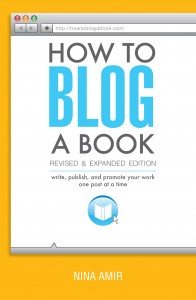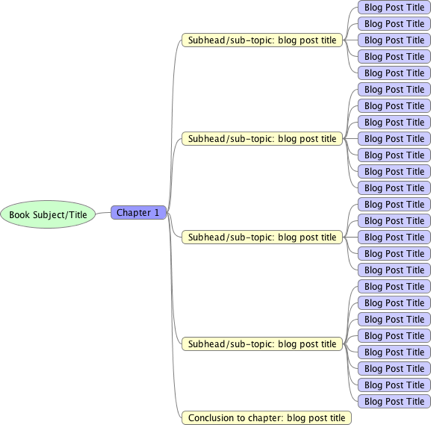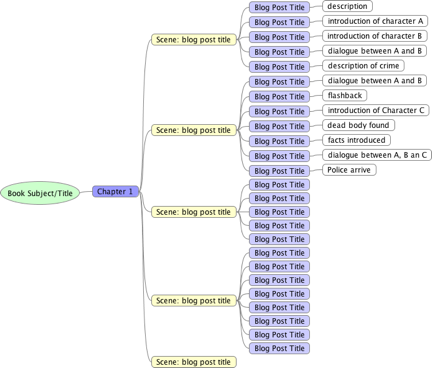 I know few writers who feel they have enough time to work on their books. Most tell me they want to be more effective and productive because they need to promote their books as well as write them. That’s why I developed the blog-a-book strategy. It allows you to write, publish and promote a book all at the same time.
I know few writers who feel they have enough time to work on their books. Most tell me they want to be more effective and productive because they need to promote their books as well as write them. That’s why I developed the blog-a-book strategy. It allows you to write, publish and promote a book all at the same time.
As you intentionally publish the first draft of your book post by post on your blog, you effectively build a readership for that work. You develop a group of loyal fans ready and willing to purchase the final edition when you release it in print or digital version.
If you’d like to work smarter, not longer and harder, and write a book on your blog—or as you blog, follow these basic steps to plan out your nonfiction or fiction blogged book.
Create Your Blog-a-Book Plan
Once you have the topic or story line for your book, it’s time to determine the contents of your book. In the initial stages of blogging a book, this is not that much different than planning a book you write the “normal” way.
1. Brainstorm your book’s content.
Begin with a brainstorming activity. Allow yourself to consider all the possible content or story lines your book could include. You can do this with a mind map. If you prefer, use an outline. Novelists and memoirists often like a timeline for this exercise. (For more information on how to mind map your book, click here.)
Think about all the subjects, research, characters, facts, scenes, turning points, life events, etc., you might want to include. Produce a brain dump of ideas.
2. Create a table of contents.
When you are done brainstorming the subjects and stories that you will include in your manuscript, organize that content into a table of contents. Give your book structure by turning the mish-mash of ideas into chapters that flow from one to the next logically.
To do this, you need to create your novel’s story line or determine the best sequence for the information that will comprise your nonfiction book. Find the major life events to include in your memoir.
3. Plan Your Posts
Next, break down the content you have planned for each chapter of your book into post-sized bits. Publish each one of your chapters on your blog in 300-700-word pieces—blog posts. To make this easier, create a blog plan. Turn what normally would be many long chapters (each one several thousand words in length) into numerous short posts.
If you write nonfiction, think of each blog post as a subtopic or a subheading in your chapter. Create 15 to 20 subheadings (or posts) per chapter. To adequately address some of these subtopics, you might need to write more than one post. Note these additional posts in your plan, possibly even with a blog post title.
When you finish, your blog-a-book plan might look like this:
If you write fiction, plan out the scenes in each chapter and break them into post-sized bits. You also might use longer bits of dialogue or description as individual posts. Each one of these small parts of your chapter gets turned into a blog post. (Sometimes your posts will be longer to accommodate a whole scene.)
I’m not a novelist, but to give you an idea of how your blog-a-book plan might look, here’s an example of one chapter with some of the details planned out as posts.
4. Create a blogging schedule.
Once you complete your plan, create a blog schedule. Decide how many days per week you will blog your book and stick to it. The more often you blog, the faster you gain readers. You also get your book written faster.
It’s better to publish shorter posts more often (especially when trying to build platform). Don’t publish 2,000-word posts once every two weeks. (Remember, you are not serializing your book.) Overly long and infrequent blog posting doesn’t attract readers and makes the book writing process feel harder. Plus, it will take longer. Blog your book in too short a period and you won’t attract many readers either.
To figure out how long it will take you to blog your book, determine the length of your book. Then divide this number by your average post length, for example, 500 words.
If you publish three posts per week, each one about 500 words long, and you write a 10,000+ e-book in seven weeks. Or publish 100 posts, each one about 500 words long, and you produce a 50,000-word manuscript. Publish posts three times per week, and you finish that manuscript in 34 weeks.
Publish more posts more often to finish your book faster. Or increase the length of your posts to complete in record time.
The Final Step
 Before you plan your blogged book content and schedule, be sure your idea is marketable. I suggest going through the basic steps of evaluating an idea prior to writing. Do this by creating a business plan for your book that includes a market and competitive analysis. Use the information you gain to craft a book idea that targets your market and provides a unique and necessary offering in the appropriate bookstore category.
Before you plan your blogged book content and schedule, be sure your idea is marketable. I suggest going through the basic steps of evaluating an idea prior to writing. Do this by creating a business plan for your book that includes a market and competitive analysis. Use the information you gain to craft a book idea that targets your market and provides a unique and necessary offering in the appropriate bookstore category.
Complete all these steps and you are ready to write, publish and promote at the same time—to become a more effective and productive writer.
To learn more about blogging book and booking blogs, purchase a copy of How to Blog a Book Revised and Expanded Edition in the Writer’s Digest Shop.



I love this idea, and I’m not generally paranoid, but how would you prevent someone from stealing your as-yet-unpublished work?
Mimi,
You have more to fear from obscurity than theft of your work…said someone wiser than me.
Read this:
https://howtoblogabook.com/copyright-how-to-protect-your-blogs-and-blogged-books/